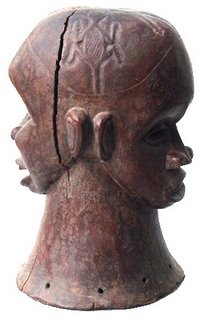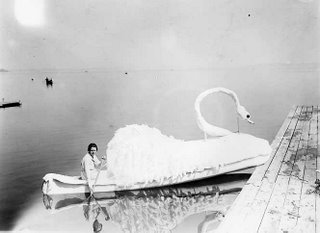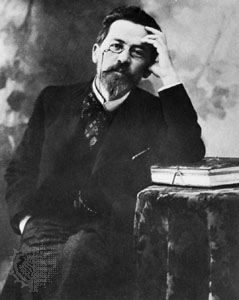 From October 23 to November 8, Pig Iron’s core company was in residence at the Temple University MFA Acting Program, in Philadelphia. This two-and-a-half week period was our first workshop of CHEKHOV LIZARDBRAIN, a new creation we will present in March of 2007. CLB springs from a collision of two sources: first, a fascination with Chekhov’s characters, their language, and their amazing ability to not-listen. The second source is a neurobiological theory we came across in autistic author
From October 23 to November 8, Pig Iron’s core company was in residence at the Temple University MFA Acting Program, in Philadelphia. This two-and-a-half week period was our first workshop of CHEKHOV LIZARDBRAIN, a new creation we will present in March of 2007. CLB springs from a collision of two sources: first, a fascination with Chekhov’s characters, their language, and their amazing ability to not-listen. The second source is a neurobiological theory we came across in autistic author -- Excited about our work on ‘contact with the past and contact with the future’ as ACTIONS that an actor can PLAY and that seem to animate Chekhov. This work sprang from all our frustrations trying to enact the “human brain” – how is it different from “real life as a person”? We tried to focus on things that only humans can do: symbolic thinking; self-awareness; two-feelings-at-once; ambivalence; ability to construct a past and a future.

We worked on the rhythms of living in the past, living in the future. The “gaze” of “living in the future” is just what you’d expect – the eyes just a little above the horizon-line. As though we have a spatial notion of “future” as “just over the next rise.” Also, these states immediately slow the gait; and the deeper you go into future or past, the thicker the molasses you walk through.
-- Excited to continue this work on ‘rhythm = reason’ and ‘motivation is more rhythm than psychology.’ I realized that I wanted to say to our audience: “Actually, I don’t know why people talk.” That is, the notion that talking is expression of feeling or calculations towards an objective – that seems, on examination, patently false. Especially in this world of Chekhov, which is so deeply rhythmic and disconnected, as far as logical argument. All the music he insists on. It seems that Chekhov is very keyed into the notion that sometimes you hear a sound and then repeat it, or make a complementary sound in return. This isn’t arbitrary, but it also isn’t “rational.”

-- Making lines not sound “like lines.” This is a pretty rudimentary way of putting it, but it’s something that Pig Iron hasn’t had to work through so directly in the past, because of the fluidity we have typically between performer and playwright. In this Chekhov world, it seems that you need support from your stage-mates – but this ISN’T the same as FOCUS, especially in the sense of ‘listening to what is being said.’ When we did our “bad party” improvisations, we found something like 70% non-listening, and this general noise creates pockets of anonymity and ‘privacy.’ These “eddies” and “swells” make space for certain things to be said, repeated. Chekhov seems to be a master of ‘that which is said while no one pays attention.’ For instance, Andre’s complaints that he hasn’t slept, which come soon after his first entrance, right as he is being teased in front of the group – it just doesn’t work that he “continues” this disjointed speech if everyone is paying attention, silently, to his protestations.
So here we have an actor-script problem that can’t be resolved just by an individual actor concentrating on the truthfulness of his or her performance – you must put your focus on the group’s work creating a texture, calibrating a sound level.
 -- “A bad party” as a theme – acts 1 and 2 of THREE SISTERS as parties that no one quite wants to attend. A party where everyone lives in the future or the past – hilarious, painful, enjoyable to us.
-- “A bad party” as a theme – acts 1 and 2 of THREE SISTERS as parties that no one quite wants to attend. A party where everyone lives in the future or the past – hilarious, painful, enjoyable to us.
-- Two emotions at the same time: a human brain phenomenon, something that Temple Grandin points out as she outlines the differences between autistic people and other people. Like dogs, she says, autistic people do not report ambivalence, they cannot love and hate at the same time. While so much of our acting research has been on isolating “one thing at a time”, this work of “having two emotions at the same time” makes for a great ‘etude.’ Improvisations around “ambivalence” were often frustrating as they tended towards apathy. Being “full up” of two emotions, like those syringes of glue that don’t bind until the two components are squeezed together – this is quite moving, sometime breath-taking in a literal sense. The actor is often immobilized by the exercise, sometimes not breathing, and when the actor does breathe, it’s in a terrifically broken rhythm.
Watchers spoke of how unnerving it is to watch someone have these two emotions at once; how strongly we want the actor to resolve it, how hard it is to see something “full up” but without a name. We tried putting the state into movement, but it is almost impossible – movement resolves the emotions into a single, clearer state. Makes sense, often when we are caught in a reverie we’ll try to “get moving” to clear our heads.
Lizardbrain.
 Beautiful but demands a lot from an audience. Hard to put in context. Hard to speak or sound from here, and sometimes the speaking lizardbrain becomes a kind of “cowboy” persona. (The long stare, the lack of emotion, can be coded this way).
Beautiful but demands a lot from an audience. Hard to put in context. Hard to speak or sound from here, and sometimes the speaking lizardbrain becomes a kind of “cowboy” persona. (The long stare, the lack of emotion, can be coded this way).
Most moving is to watch bodies together unaware of social convention, unaware of what parts of the body are “hot” – faces, palms, etc. So a face can end up in an armpit and there is no reaction. Sarah said “from inside this brain, I felt like all the parts of the body I was seeing had an equal value.” So it opens up possibilities for space and touch.
 Pure joy. Much, much richer than I imagined. A perfect place to begin work with clown, work with commedia. Having just ONE emotion at a time, it’s infectious, hilarious, immediately interpretable. So much of life as we know it turns out to be dogbrain.
Pure joy. Much, much richer than I imagined. A perfect place to begin work with clown, work with commedia. Having just ONE emotion at a time, it’s infectious, hilarious, immediately interpretable. So much of life as we know it turns out to be dogbrain.
Just working on the exercise “One emotion at a time” unleashes a host of behaviors: playfulness; hierarchy; looking for attention; extra energy in the limbs, a kind of roundness in trajectory and in movement.
-- Future dogbrain work involves:
How to repeat such a pure and instinctual, non-lying state with a set script or choreography. Challenging.
How to avoid ‘dogginess’; it’s not about the shape of the dog or the patterns of the dog, it’s a state that we can translate onto our human bodies and gestures.
Sexual desire without shame or forethought – or even understanding of the mechanics?
How to find moments of calm, of blankness, or of smaller energy – although it seems that some “emotions” DO exist just at 100%, there must be emotions that demand less than total energy from the performer.
 --- Will CHEKHOV LIZARDBRAIN be a series of etudes, or a story, or a landscape? How much vocabulary does the audience need to enjoy these states the way that we have in this workshop? As we approach the end of this period, we are drawn more to a geometric, theatrical space; a stage to present states on, as opposed to a setting. This is so challenging to costume, as well – the costumes will, to some degree, signal to the audience where we are.
--- Will CHEKHOV LIZARDBRAIN be a series of etudes, or a story, or a landscape? How much vocabulary does the audience need to enjoy these states the way that we have in this workshop? As we approach the end of this period, we are drawn more to a geometric, theatrical space; a stage to present states on, as opposed to a setting. This is so challenging to costume, as well – the costumes will, to some degree, signal to the audience where we are.
3 comments:
This is wonderful material--I am very VERY happy you are doing this and allowing blogwatchers into this much of your creative process. As with many other creations, once finished the process doesn't show and it is at least as fascinating as the final product. Terrific!!!
Your blog keeps getting better and better! Your older articles are not as good as newer ones you have a lot more creativity and originality now keep it up!
great article. I would love to follow you on twitter.
Post a Comment